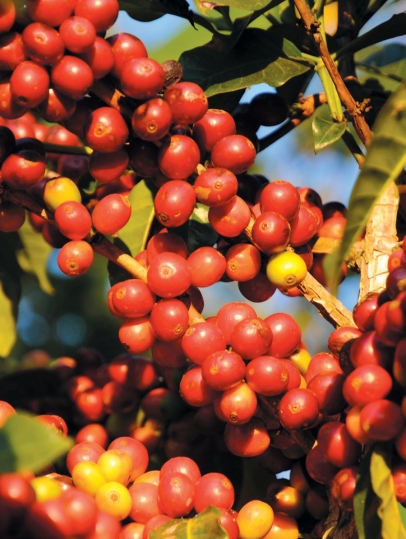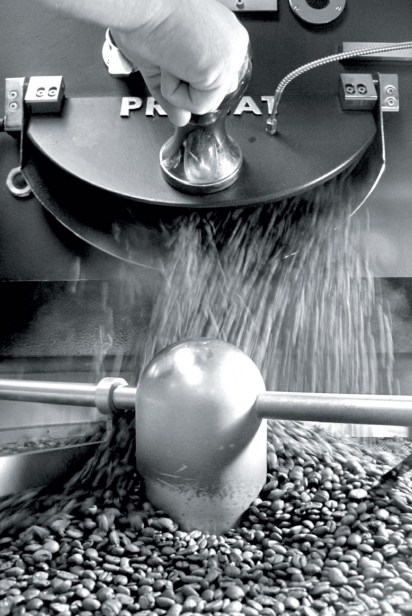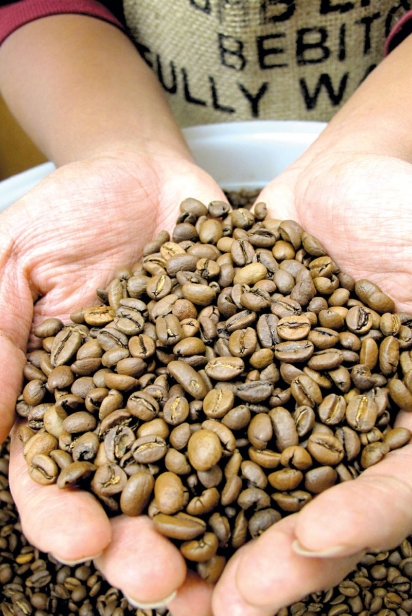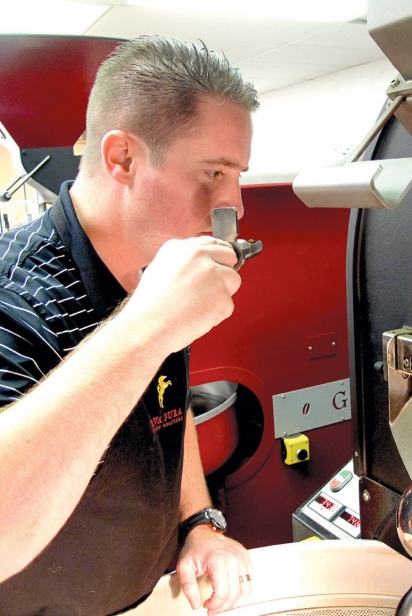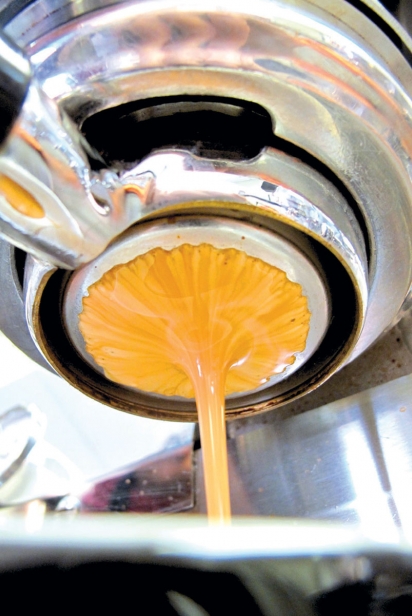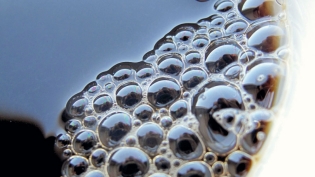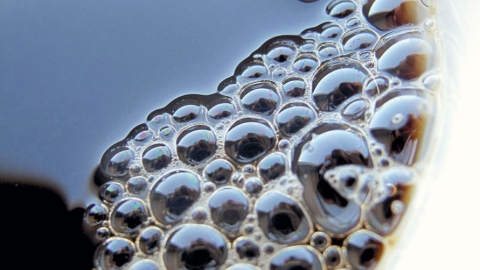The Green Bean Before the Dark Brew - How Real Roasters Do It!
A Fresh Smell Of Hay And A Hint Of Citrus
The red cherry-like fruit on the coffee plant holds a seed that is coveted the world over for its caffeine and aroma. Yet similar to raw pure cocoa nibs—which are harshly bitter and not in the least like chocolate—raw coffee beans need processing to develop aroma and taste. The raw green coffee bean smells of hay and grass, with a fleeting reminder of citrus—but not of coffee.
If “life’s too short to drink bad wine,” consider the same for coffee. Aroma, color, mouthfeel: when a good glass of wine is poured, we’ll give the wine credit before drinking and we’ll even know about the varietals and origin. Yet when we enjoy a good brew from beans roasted by a small local roasting company in a neighborhood coffee shop, do we ponder the single origin beans behind a specialty coffee? Do we tilt our mugs to admire the color of the coffee, sniff deeply and long—noses buried in the cup—before taking a sip to savor all the characteristics of the beans in this brew: the bright notes or earthy tones, a touch of spice or a hint of citrus?
Who better to talk to about single-origin specialty coffee than someone who himself likes to draw parallels between wine and coffee: Fielding Cocke, wine connoisseur and coffee aficionado, and co-owner, together with Richard Colt, of Java Pura (javapura.com). Cocke learned the trade of coffee roasting from a master roaster¬ and later taught his son, Alexander Cocke, who has been Java Pura’s roaster for the last two-and-a-half years.
“Where the bean grows, the topography, soil, climate and season (was it wet or dry, hot or mild, early or late season), all impact the taste of the coffee. Terroir, to me, is what creates the inimitable taste of the coffee. For example, if you compare a Sumatra Iskandar and a Costa Rica Don Teofilo you’ll find that the Costa Rica has very bright notes and bright acids with good medium body whereas the Sumatra has very earthy tones in the aromatics, almost like a pleasant smell of earth. Those are the things we celebrate in a single-origin coffee,” says Cocke.
Single Origin (SO) coffee comes from a single plantation. What distinguishes specialty coffee from commercial grade is quite literally the perfect bean: a specialty coffee bean has no imperfections. Obtain a perfect bean starts with the harvest. The cherries are selectively picked at their prime and at even ripeness—as opposed to strip picking, where all cherries from the bush are removed at once regardless of their level of ripeness.
Producing the perfect bean continues with the milling process. In wet milling, it comes down to clean water for soaking, removing floating (bad or unripe) beans and the right level of fermentation to remove the husks. In dry milling, it is the care taken to constantly rake the cherries drying out in the sun to ensure even drying and no mildew. Husks removed, the next step is selection. Specialty beans can have no imperfections: no chipped beans, no other materials, and moisture levels that are maintained at an ideal 11%. The selected dried green coffee beans are put in white sacks in open-air warehouses to rest for 2–3 months.
Having direct relations with an exporter in Costa Rica helps Java Pura find fastidious coffee farmers like Don Teofilo, a fourth-generation coffee plantation in Costa Rica’s Los Santos region. It is a specialty coffee plantation growing varieties that include Caturra, Catuai, Typica and Geisha. Java Pura buys the entire crop, which increased from about 50 bags in 2008 to about 125–150 bags today (each bag being 152 pounds). “We taste the coffee on the farm. Then they send it to our exporter who roasts it on sample roasters. We cup it and taste it again. After 2–3 months in reposo (rest) we cup and taste it again. So we are constantly cupping it, and they know we are.”
Single-origin specialty beans are important for small-business artisanal roasting companies. It is where they distinguish themselves from big coffee companies—similar to how small single-vineyard wineries do from big wine houses. While big companies like Starbucks need to buy massive quantities of beans to ensure that their coffee blends taste the same from Seattle to Houston and the world over, smallbusiness roasting companies can focus on single-origin coffees and create their own unique blends that you find no where else.
Knowing the flavor profile of the green bean helps determine the temperature at which it should be roasted to get the best result. “We recently tried out different roasting temperatures for a new single-origin from Nicaragua,” says Cocke. “We threw it in the roaster and started different roasts, you know: light roast, medium, medium plus… We stopped and cupped at every level: ‘At what temperature does this coffee truly shine?’”
Comparing a good blend coffee to a classic Bordeaux—a blend of Cabernet Sauvignon, Merlot, Petit Verdot and Cabernet Franc—Fielding Cocke agrees that blending is “fun and interesting” while at the same time stressing that a single-origin specialty coffee doesn’t need blending: It has a unique flavor profile to enjoy all by itself. One of the most outstanding single-origin variety coffees is Geisha (the adapted spelling of the original Gesha): “It is a single variety,” says Cocke. “Geisha cherries are not mixed with other cherries, not even of the same place of origin. Geisha beans are picked, milled and processed alone.”
For a coffee drinker who cares about his brew, it pays to visit small coffee shops that pride themselves in using roasts from local smallbusiness roasters. And perhaps next time you savor a good coffee you will give it the five S’s of tasting: see, sniff, swirl, sip and savor!
WHAT’S LEFT WHEN THE BEANS ARE BREWED?
Whether roasted dark or medium, used for espresso or a cold brew, the coffee grounds that remain should not be discarded. You can go as far as drying out the damp coffee grounds and using them (sparingly) in a spice rub or even in baking— but keep in mind that used coffee grounds are rather bitter and concentrated.
Used coffee grounds are great odor absorbers. When my hands reek of garlic and onion after cooking, a quick rub with a pinch of used coffee grounds washed off with water and soap gets rid of the lingering smell. You could keep a small container of used coffee grounds in the fridge for the same effect: It absorbs unwanted odors.
Used coffee grounds make great compost. They are a good source of nitrogen for soil. Thomas Garcia-Prats of Finca Tres Robles (smallplaces.org) shares a few tips: “Fresh coffee grounds can be very acidic. Some plants thrive in acidic soil, like azaleas. If you don’t want the acidity, compost the coffee grounds first to neutralize their pH. It is easily done. Just throw your coffee grounds in your compost pile as you brew. Or if you don’t have one, keep them in a five-gallon bucket. When it’s full, give it to someone who has a compost pile (or azaleas). Or you can bring it by the farm and we’ll put it to good use!”
COFFEE CHERRY TEA
The dried husks that are left after milling the green beans are finding their way into customers’ cups everywhere: as a tea. With their reddish hues and hints of raisins the dried coffee cherry husks are packed with the natural sugars and tannins of the original fruit. Steeped in boiling hot water they take on the quality of an herbal tea—one that reminds of Rooibos. Java Pura has Cascara in their selection, a coffee cherry tea produced by Oscar & Francesca Chacon from Las Lajas Micro Mill in Costa Rica’s Central Valley.


